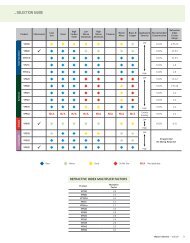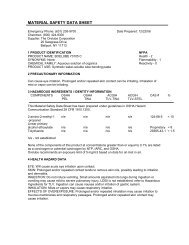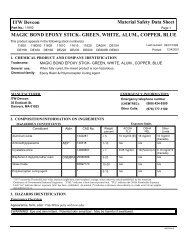Download Datasheet - Travers Tool Company, Inc.
Download Datasheet - Travers Tool Company, Inc.
Download Datasheet - Travers Tool Company, Inc.
You also want an ePaper? Increase the reach of your titles
YUMPU automatically turns print PDFs into web optimized ePapers that Google loves.
TRG250/TRQ250EYE or SKIN contact with the product, vapor or spray mist.EFFECTS OF OVEREXPOSUREEYES: Irritation.SKIN: Prolonged or repeated exposure may cause irritation.INHALATION: Irritation of the upper respiratory system.HMIS CodesHealth 2*Flammability 3Reactivity 0May cause nervous system depression. Extreme overexposure may result in unconsciousness and possibly death.Prolonged overexposure to solvent ingredients in Section 2 may cause adverse effects to the liver, urinary, blood forming, cardiovascular andreproductive systems.SIGNS AND SYMPTOMS OF OVEREXPOSUREHeadache, dizziness, nausea, and loss of coordination are indications of excessive exposure to vapors or spray mists.Redness and itching or burning sensation may indicate eye or excessive skin exposure.MEDICAL CONDITIONS AGGRAVATED BY EXPOSURENone generally recognized.CANCER INFORMATIONFor complete discussion of toxicology data refer to Section 11.SECTION 4 — FIRST AID MEASURESEYES:SKIN:INHALATION:INGESTION:Flush eyes with large amounts of water for 15 minutes. Get medical attention.Wash affected area thoroughly with soap and water.Remove contaminated clothing and launder before re-use.If affected, remove from exposure. Restore breathing. Keep warm and quiet.Do not induce vomiting. Get medical attention immediately.SECTION 5 — FIRE FIGHTING MEASURESFLASH POINTLEL UEL FLAMMABILITY CLASSIFICATION10° F PMCC0.913.1 RED LABEL -- Extremely Flammable, Flash below 21° F (-6 °C)EXTINGUISHING MEDIACarbon Dioxide, Dry Chemical, FoamUNUSUAL FIRE AND EXPLOSION HAZARDSClosed containers may explode when exposed to extreme heat.Application to hot surfaces requires special precautions.During emergency conditions overexposure to decomposition products may cause a health hazard. Symptoms may not be immediatelyapparent. Obtain medical attention.SPECIAL FIRE FIGHTING PROCEDURESFull protective equipment including self-contained breathing apparatus should be used.Water spray may be ineffective. If water is used, fog nozzles are preferable. Water may be used to cool closed containers to prevent pressurebuild-up and possible autoignition or explosion when exposed to extreme heat.SECTION 6 — ACCIDENTAL RELEASE MEASURESSTEPS TO BE TAKEN IN CASE MATERIAL IS RELEASED OR SPILLEDRemove all sources of ignition. Ventilate the area.Remove with inert absorbent.SECTION 7 — HANDLING AND STORAGESTORAGE CATEGORYDOL Storage Class IBPRECAUTIONS TO BE TAKEN IN HANDLING AND STORAGEContents are EXTREMELY FLAMMABLE. Keep away from heat, sparks, and open flame. Vapors will accumulate readily and may igniteexplosively.During use and until all vapors are gone: Keep area ventilated - Do not smoke - Extinguish all flames, pilot lights, and heaters - Turn offstoves, electric tools and appliances, and any other sources of ignition.Consult NFPA Code. Use approved Bonding and Grounding procedures.Keep container closed when not in use. Transfer only to approved containers with complete and appropriate labeling. Do not take internally.Keep out of the reach of children.SECTION 8 — EXPOSURE CONTROLS/PERSONAL PROTECTIONPRECAUTIONS TO BE TAKEN IN USEUse only with adequate ventilation.Avoid contact with skin and eyes. Avoid breathing vapor and spray mist.Wash hands after using.page 2 of 5







